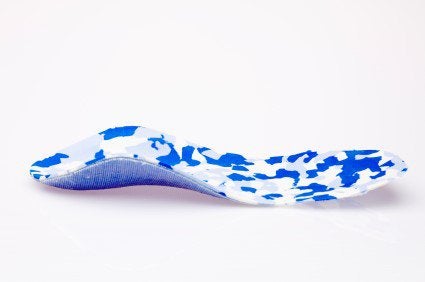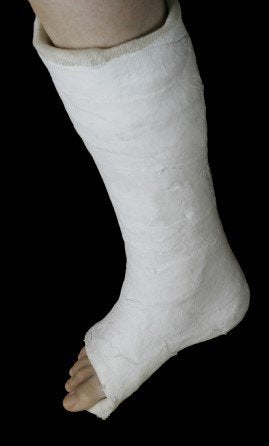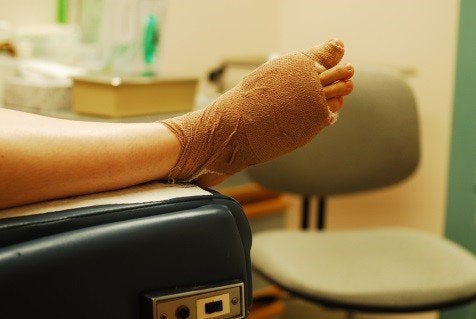-
Growing Shoe Made to Last Created for Children in Third World Countries
 Children all around the world grow out of their shoes so quickly that many parents, especially, in third world countries, cannot afford to buy their children shoes. The Shoe That Grows , designed by Kenton Lee, was created to combat this problem by allowing the shoe to expand up to five sizes and by lasting up to five years. Lee was inspired when he went on a trip to Kenya and saw many children running around barefoot, making them especially susceptible to diseases and infections. The leather and rubber materials make the shoes especially durable and come in size small (for children grades kindergarten to fourth grade) and size large (grades fifth to ninth).
Children all around the world grow out of their shoes so quickly that many parents, especially, in third world countries, cannot afford to buy their children shoes. The Shoe That Grows , designed by Kenton Lee, was created to combat this problem by allowing the shoe to expand up to five sizes and by lasting up to five years. Lee was inspired when he went on a trip to Kenya and saw many children running around barefoot, making them especially susceptible to diseases and infections. The leather and rubber materials make the shoes especially durable and come in size small (for children grades kindergarten to fourth grade) and size large (grades fifth to ninth). Having shoes for children is essential in allowing them to grow properly and keeping them disease free. If you have any concerns contact Dr. Jon M. Sherman of Kentlands Foot and Ankle Center . Our doctor will treat your foot and ankle needs.
Keeping Children’s Feet Healthy
Having healthy feet in childhood can help prevent medical problems later in life, namely in the back and legs. As children grow, their feet require different types of care from birth to school-age.
Although babies do not walk yet, it is still very important to take care of their feet.
- Avoid putting tight shoes or socks on his or her feet
- Allow the baby to stretch and kick his or her feet to feel comfortable
As a toddler, kids are now on the move and begin to develop differently. At this age toddlers are getting a feel for walking, so don’t be alarmed if your toddler is unsteady or ‘walks funny’. Be sure the child wears comfortable and protective shoes so that they can grow into their feet properly.
As your child gets older, it is important to teach them how to take care of their feet
- Show them proper hygiene to prevent infections such as fungus
- Be watchful of any pain or injury
- Have all injuries checked by a doctor as soon as possible
- Comfortable, protective shoes should always be worn, especially at play
Children of all ages are constantly developing and growing, and as a parent you want to make sure that nothing is hindering their maturation.
If you have any concerns feel free contact our office located in Gaithersburg, MD . We offer the newest diagnostic tools and technology to treat your foot and ankle needs.
Read more about keeping children’s feet healthy.
-
Standing on your Feet at Work for a Few Hours a Day can Optimize Health
According to a study conducted through Public Health England and community interest group of the UK, office employees should stand on their feet for two hours of their work day to maintain optimal health. The researchers recommend two hours of walking or light activity during work hours, regularly breaking up seated work with standing work, alterations of posture while standing so soreness does not occur during the change in office behaviors, and encouraging other healthy activities.
While working on the feet, it is important to take the proper care of them. For more information about working on your feet contact Dr. Jon M. Sherman of Kentlands Foot and Ankle Center . Our doctor will treat your foot and ankle needs.
Working on Your Feet
Standing on your feet for long periods of time can cause stress and pain in your feet. Your whole body may experience change in terms of posture, back pain, bunions, callouses and or plantar warts. There are ways to avoid these conditions with proper foot care, smart choices and correct posture.
Positive Changes
Negative heeled shoe – choosing this shoe places the heel slightly lower than the ball of the foot. These are great for overall foot health. Find shoes that fit you correctly.
Go barefoot – our feet were not designed to be enclosed for hours, or all day. Try allowing yourself to expose your feet to air.
Eliminate Pain
Foot Exercises – performing simple exercises, incorporating yoga and stretches is beneficial. This will allow increased blood flow to the area and muscles of the foot.
Achilles tendon – stretching the foot out flat on the floor, will relax the calf muscles and tendon. These exercises can be performed almost anywhere. Make sure you add these exercises to your daily regimen.
With a little bit of this information and knowing more about foot health, you will notice changes. Foot stretches and proper footwear will help with pain and prevent further issues.
Keep your feet healthy and your body will thank you for it.
If you have any questions please feel free to contact our office located in Gaithersburg, MD . We offer the newest diagnostic and treatment technologies for all your foot and ankle needs.
Read more about working on your feet.
-
Working on Your Feet
Overworking your feet can put stress on your entire body, so taking care of your feet is an absolute priority for overall good health. Standing all day can cause a myriad of different conditions such as bunions, callouses, and plantar warts. These conditions are all very painful but can be avoided with proper foot care, which includes both proper posture and good shoe choices to contribute to the overall health of your feet.
A good place to start is choosing a show that has a negative heel which places the heel slightly lower than the ball of the foot, as shoes designed this way are best for your foot health. Having a job that keeps you on your feet all day makes it an especially a good idea to spend the extra money on a good pair of shoes. And most definitely purchase your shoes from a reputable manufacturer who puts foot health at the forefront of their goals. Having a job that keeps you on your feet all day makes it an especially a good idea to spend the extra money on a good pair of shoes.
The feet were not designed to be enclosed for hours on end. In fact, incorporating some “barefoot” time into your daily routine is not a bad idea to improve overall foot health. There are some other simple things that you can do to help alleviate pain and pressure on the feet from standing all day.
One of the first things you can do is perform some simple foot exercises and some common yoga moves to improve the function of your feet. Foot work outs that aid in your movement will stimulate blood flow and muscles of your feet. Yoga exercises that stretch your feet out flat on the floor can be very beneficial for you if you work on your feet all day. It can also help stretch and relax the calf muscles and Achilles tendon, both of which can become problem areas if not taken care of. You can perform these exercises every day during your daily routine, at the office, at the gym, or even before you go to bed simply stretching your feet out can do wonders for your foot health.
Foot pain that occurs every day because you work for long hours on your feet may lead you to think that this pain is inevitable. However, it does not have to be. Foot stretches and proper footwear work well in alleviating foot pain and preventing further foot problems.
With a little effort and s ome education, you can keep your feet healthy and feeling good. If your feet hurt, your whole body will eventually feel the effects over time. Start taking care of your feet today!
-
New York Yankees Gets New Orthotics after Foot Flare Up
 Brian McCann of the New York Yankees has been fitted with new orthotics after experiencing some arch pain while on the field. “I had the same mold for the last three years. The arch on my foot has changed” McCann stated, starting conversation on the importance of regularly ordering new orthotics to reflect changes in the foot. The hitter recalls how nerve wracking it was to have his foot flare up again leaving that asleep and tingly feeling in the foot and lower leg. After having an MRI and CT scan of the foot, McCann has no serious injuries, he just needed new orthotics.
Brian McCann of the New York Yankees has been fitted with new orthotics after experiencing some arch pain while on the field. “I had the same mold for the last three years. The arch on my foot has changed” McCann stated, starting conversation on the importance of regularly ordering new orthotics to reflect changes in the foot. The hitter recalls how nerve wracking it was to have his foot flare up again leaving that asleep and tingly feeling in the foot and lower leg. After having an MRI and CT scan of the foot, McCann has no serious injuries, he just needed new orthotics. If you are having discomfort in your feet and would like to try orthotics, contact Dr. Jon M. Sherman of Kentlands Foot and Ankle Center . Our doctor will treat your foot and ankle needs.
What are Orthotics?
Orthotics are inserts you can place into your shoes to help with a variety of foot problems such as flat feet or foot pain. Orthotics provide relief and comfort for minor foot and heel pain, but can’t correct serious biomechanical problems in your feet.
Over-the-Counter Inserts
Orthotics come in a wide variety of over-the-counter inserts that are used to treat foot pain, heel pain, and minor problems. For example, arch supports can be inserted into your shoes to help correct over arched or flat feet, while gel insoles are often used because they provide comfort and relief from foot and heel pain by alleviating pressure.
Prescription Orthotics
If over-the-counter inserts don’t work for you, or if you have a more severe foot issue, it is possible to have your podiatrist prescribe custom orthotics. These high quality inserts are designed to treat problems such as abnormal motion, plantar fasciitis, and more severe heel pain. They can even be used to help patients suffering from diabetes by treating foot ulcers and painful calluses, and are usually molded to your feet individually, which allows them to provide full support and comfort.
If you are experiencing minor to severe foot or heel pain, it’s recommended to speak with your podiatrist on the possibilities of using orthotics. A podiatrist can determine which type of orthotic is right for you and allow you to take the first steps towards being pain free.
If you have any questions please feel free to contact our office located in Gaithersburg, MD . We offer the newest diagnostic tools and technologies to treat your foot and ankle needs.
-
Ankle Foot Orthotics For Athletes
Ankle and foot orthotics, known as AFOs, are custom-made inserts, shaped and contoured to fit inside a shoe and used to correct an irregular walking gait or provide cushioning. Orthotics come in a variety of different models and sizes, including both over the counter and customizable variants. Customizable ones should be prescribed through a podiatrist who specializes in customized footwear and orthotics design and management.
AFOs are often used by athletes including track and field runners, cyclists, professional dancers, ice skaters, and even golfers. They benefit a lot from custom made AFOs by preventing injuries from occurring and provide cushioning to keep pain levels down to a minimum. Ankle foot orthotics allow for the correct positioning of the feet and also act as shock absorbers to help keep pressure and stress off the foot and ankle. They can also relieve back pain and hip pain while restoring balance and improving an athlete’s performance.
The way they help alleviate pain is by controlling the movement of both your feet and ankles. They are custom designed by a podiatrist or orthopedic specialist to help treat foot problems such as flat feet, spurs, arthritis of the ankle or foot, ankle sprains, weakness, and drop foot, a condition in which the patient cannot raise their foot at the ankle joint.
With custom orthotics, a patient will go through a complete examin ation of the foot and ankle, followed by the ankle and foot being cast and fitted for the proper orthotic. Depending upon the final result of the tests, a stretching treatment is created with specific shoe fitting in mind. After they have been fitted to the shoes, adjustments can be made in order to get the perfect fit and completely fill out the shoe. Evaluations are then usually set up to monitor the patient in the coming weeks to see how they are adjusting.
AFOs are also available over the counter and are more common than custom fit ones. Athletes that have generally low aches and pains in the foot, ankle, or lower back area can use an over the counter version of these orthotics. Weight is still distributed evenly throughout the bottom of the foot thanks to the arch support they give, but when an injury or ailment occurs, it is usually not enough to try and remedy it with an over the counter version. In either case, a podiatrist will be able to offer the best advice and treatment when it comes to foot and ankle orthotics and handle all your foot care needs.
-
Exercises for Pregnant Women and their Feet
 Although soon-to-be moms have many things to take care of during pregnancy, it is additionally important that feet and ankles are paid attention to. During pregnancy many women experience natural weight gain in addition to swollen ankles, feet, and flat feet. Accordingly there are certain exercise techniques that can help reduce these foot ailments. If sitting for a long period of time, take short walks regularly to reduce swelling in the feet and ankles. To reduce over-pronation or flattening of the arch, stretch the calves, rotate the ankles in a circular motion, and try the reverse and standing calf raise.
Although soon-to-be moms have many things to take care of during pregnancy, it is additionally important that feet and ankles are paid attention to. During pregnancy many women experience natural weight gain in addition to swollen ankles, feet, and flat feet. Accordingly there are certain exercise techniques that can help reduce these foot ailments. If sitting for a long period of time, take short walks regularly to reduce swelling in the feet and ankles. To reduce over-pronation or flattening of the arch, stretch the calves, rotate the ankles in a circular motion, and try the reverse and standing calf raise. Pregnancy can put a tremendous amount of stress on the feet. If you have any concerns contact Dr. Jon M. Sherman of Kentlands Foot and Ankle Center . Our doctor will treat your foot and ankle needs.
What foot problems can arise during pregnancy?
One problem that can occur is over-pronation, which occurs when the arch of the foot flattens and tends to roll inward. This can cause pain and discomfort in your heels while you’re walking or even just standing up, trying to support your baby.
Another problem is edema, or swelling in the extremities. This often affects the feet during pregnancy, but tends to occur in the later stages.
How can I keep my feet healthy during pregnancy?
- Wearing orthotics can provide extra support for the feet and help distribute weight evenly
- Minimize the amount of time spent walking barefoot
- Wear shoes with good arch support
- Wear shoes that allow for good circulation to the feet
- Elevate feet if you experience swelling
- Massage your feet
- Get regular, light exercise, such as walking, to promote blood circulation to the feet
If you have any questions please feel free to contact our office located in Gaithersburg, MD . We offer the newest diagnostic tools and technology to treat your foot and ankle needs.
Read more about pregnancy and feet.
-
Pregnancy and Foot Health
Many pregnant women complain about foot pain while they are expecting, primarily caused by weight gain and hormonal changes taking place in the body. By understanding how pregnancy impacts the health of a woman’s feet, a pregnant woman can take action to keep her feet as healthy and comfortable as possible.
Because a woman’s weight changes during pregnancy, more pressure is brought to bear on both the legs and the feet. This weight shift can cause two major foot problems: over-pronation, also known as flat feet, as well as edema, which is swelling of the feet. Over-pronation occurs when the arch of the foot flattens, causing the foot to roll inwards when the individual is walking, and can aggravate the plantar fascia tissues located along the bottom of the feet. If these tissues become inflamed, a pregnant woman can experience pain in the heel of the foot as well as severe foot pain while walking or standing. Swelling of the feet, or edema, often occurs in the later stages of pregnancy, caused by slow circulation and water retention, and may turn the feet a light purple color.
To keep feet in good health and prevent over-pronation, pregnant women should avoid walking barefoot and be sure they are wearing shoes that offer good arch support. Often a device known as an orthotic can be added to regular footwear in order to provide additional support for the feet during pregnancy. Any expectant mother whose feet hurt should first check to see if the shoes she is wearing are old, worn out and not offering the arch of the foot the proper support necessary to support and distribute the weight of her body during pregnancy.
To treat edema of the feet, a good start is to wear quality footwear which offers support and good circulation. Keep feet elevated whenever possible by using a foot stool while seated. Stay well hydrated by drinking plenty of water to prevent water retention in the feet. Any swelling that occurs in only one foot should be examined as soon as possible by a doctor.
Good foot health during pregnancy can help expectant mothers avoid foot pain that leads to other health problems. Massaging the feet and doing regular gentle exercise like walking aids in foot health by contributing to good circulation. Supportive shoes are also a good investment that will support foot health during pregnancy.
-
Michal Rozsival of Chicago Blackhawks Sustains Broken Ankle
 Michal Rozsival of the Chicago Blackhawks suffered a broken ankle during Game 4 of the series against Minnesota Wild. The injury occurred when Rozsival skated backwards, fell and landed unnaturally. Although the Blackhawks still won the game and will move on into the Western Conference Final, Rozsival had to be carried off the ice by teammates Brad Richards and Duncan Keith and will not return until next season. Dr. Michael Terry confirmed the player will need surgery to treat the injury..
Michal Rozsival of the Chicago Blackhawks suffered a broken ankle during Game 4 of the series against Minnesota Wild. The injury occurred when Rozsival skated backwards, fell and landed unnaturally. Although the Blackhawks still won the game and will move on into the Western Conference Final, Rozsival had to be carried off the ice by teammates Brad Richards and Duncan Keith and will not return until next season. Dr. Michael Terry confirmed the player will need surgery to treat the injury.. Broken ankles need immediate treatment. If you have any concerns about your feet and ankles contact Dr. Jon M. Sherman of Kentlands Foot and Ankle Center . Our doctor will treat your foot and ankle needs.
Broken Ankles
A broken ankle is experienced when a person fractures their tibia or fibula in the lower leg and ankle area. Both these bones are attached at the bottom of the leg and combine to form what we know to be our ankle.When a physician is referring to a break of the ankle, he or she is usually referring to a break in the area where the tibia and fibula are joined to create our ankle joint. Ankles are more prone to fractures because the ankle is an area that suffers a lot of pressure and stress. There are some obvious signs when a person experiences a fractured ankle and the following symptoms may be present.
Symptoms of a Fractured Ankle
- Excessive pain when the area is touched or when any pressure is placed on the ankle
- Swelling around the area
- Bruising of the area
- Area appears to be deformed
If you suspect an ankle fracture, it is recommended to seek treatment as soon as possible. The sooner you have your podiatrist diagnose the fracture, the quicker you’ll be on the way towards recovery.
If you have any questions please feel free to contact our office located in Gaithersburg, MD . We offer the newest diagnostic tools and technology to treat your foot and ankle needs.
Read more about broken ankles.
-
All About Broken Ankles
Broken ankles are a serious injury that can lead to an inability to walk, function, and also cause a significant amount of pain. A broken ankle is actually a break in one of the three bones in your body that connect at the ankle joint, the tibia, the fibula, and the talus. The tibia and fibula are your two primary leg bones that connect at the knee, which sit directly upon the talus bone. This is protected by a fibrous membrane that allows for movement in our ankle joint. A broken ankle is usually caused by the foot rolling under or twisting too far, causing one of these three bones to snap.
A broken ankle is different from an ankle sprain, which occurs when the ligaments are ripped or torn but no bones have been broken. However, a sprain can still be very severe, causing bruising in the foot and an inability to hold your own weight, much like a broken ankle would. If you cannot stand on your own weight and suspect that you have a broken ankle, the first thing to do would be to get an immediate x-ray to determine the severity of the break.
A common way to break your ankle is to roll over onto it with enough pressure to break the bones, usually done while engaging in exercise, sports, or some other physical activity. Another common cause is a fall or jump from a large height.
Broken ankles can cause severe pain, but immediate relief can come from elevating the feet above your head to reduce blood flow to the injured area. You can also apply ice packs to the ankles to help reduce the swelling, redness, inflammation, and pain. After these initial steps, getting a cast on and staying off your feet as much as possible will aid in the recovery of the broken ankle, because the less movement and stress the ankle has to endure, the more complete it will heal. A doctor can determine if surgery is needed in order to heal correctly. In these cases, an operation may be the only option to ensure the ability to walk properly again, followed by physical therapy and rehabilitation.
It is highly important to determine if surgery is needed early on, because a broken ankle can become much more severe than you realize. If not professionally treated, the broken ankle will inhibit your walking, daily functioning, and produce a large amount of pain, so the quicker you act, the better.
-
New Minimally Invasive Surgery for Achilles Tendon Injuries
 Weronika Molinski was on her way to start a new fitness program in Colorado when she ruptured her Achilles tendon. Although she was unable to walk for a few months, Molinski was treated with a new minimally invasive surgery that is often compared to knitting. Doctors would use a device to attach sutures to her tendon and pull the sutures in and out of her skin. This method additionally leaves a smaller scar compared to the large vertical scar left with traditional surgeries. While Molinski was simply happy she could exercise again doctors stated, “The benefit is, by making a small incision, you’re minimizing the risk associated with fixing a tendon repair.”
Weronika Molinski was on her way to start a new fitness program in Colorado when she ruptured her Achilles tendon. Although she was unable to walk for a few months, Molinski was treated with a new minimally invasive surgery that is often compared to knitting. Doctors would use a device to attach sutures to her tendon and pull the sutures in and out of her skin. This method additionally leaves a smaller scar compared to the large vertical scar left with traditional surgeries. While Molinski was simply happy she could exercise again doctors stated, “The benefit is, by making a small incision, you’re minimizing the risk associated with fixing a tendon repair.” Achilles tendon injuries need immediate attention to avoid future complications. If you have any concerns contact Dr. Jon M. Sherman of Kentlands Foot and Ankle Center . Our doctor will treat your foot and ankle needs.
What is the Achilles Tendon?
The Achilles tendon is a tendon that connects the lower leg muscles and calf to the heel of the foot. It is the strongest tendon in the human body and is essential for making movement possible. Because this tendon is such an integral part of the body, any injuries to it can cause severe difficulties and should immediately be presented to a doctor.
What are the symptoms of an Achilles Tendon Injury?
There are various types of injuries that can affect the Achilles tendon. The two most common are Achilles tendinitis and ruptures of the tendon.
Achilles Tendinitis Symptoms
– Inflammation
– Dull to Severe Pain
– Increased blood flow to the tendon
– Thickening of the tendon
Rupture Symptoms
– Extreme pain and swelling in the foot
– Total immobility
Treatment and Prevention
Achilles tendon injuries are diagnosed by a thorough physical evaluation, which can include an MRI. Treatment involves rest, physical therapy, and in some cases, surgery. However, various preventative measures can be taken to avoid these injuries, such as:
– Thorough stretching of the tendon before and after exercise
– Strengthening exercises like calf raises, squats, leg curls, leg extensions, leg raises, lunges, and leg presses
If you have any questions please feel free to contact our office located in Gaithersburg, MD . We offer the newest diagnostic tools and technology to treat your foot and ankle needs.
Read more about Achilles tendon injuries.
RECENT POSTS
categories
- Uncategorized
- Featured Articles
- Foot Disorders
- Broken Ankle
- Broken Toe
- Fracture
- Foot Health
- Foot Care
- Arthritis
- Foot Pain
- Skin Cancer
- Podiatry Appointment
- Custom Orthotics
- Podiatrist
- Diabetes
- Gout
- Heart Health
- National Nutrition Month
- National Foot Health Awareness Month
- Foot Safety
- Foot and Ankle Injuries
- Falls Prevention
- Chronic Heel Pain
- Shoes
- Laser Therapy
- Quoted
- Physical Therapy
- KeryFlex
- Sweat
- Summer Foot Care
- Sports Injury
- ESWT
- Fungal Toenails
- Bunion


